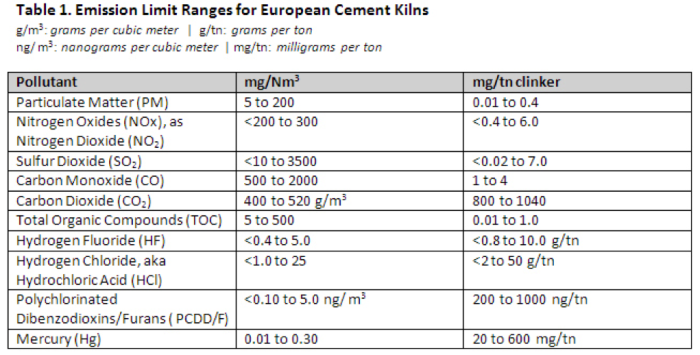Comparison: U.S. & European Cement Kiln Emission Regulations
On September 9, 2010, new emission standards for hazardous air pollutants (HAPs) from Portland cement kilns went into effect. The new Environmental Protection Agency (EPA) rules, known as PC MACT, have a significant impact on cement production in the U.S. Some in the industry feel the new limits will be very difficult, if not impossible, to meet.
Since the early 2000s, the European Union (EU) has had in place similarly strict emission limits for cement producers. This raises the question: how do EU regulations compare with PC MACT, and what have plants done to meet emission limits?
An apples-to-apples comparison of U.S. and EU cement regulations is difficult because different units of measurement are used. A few examples:
- In the EU, particulate emission limits are measured based on milligrams per normal cubic meter (mg/Nm3) of gas coming out of the kiln. In the U.S., the measure for PM is pounds per ton (lbs/tn) of clinker.
- In the EU, mg/Nm3 is also used to measure HCl, while in the U.S. this pollutant is measured in parts per million by dry volume (ppmvd).
- In the EU, the basis for a œnormal cubic meter is dry gas with 10% oxygen at 0oC. In the U.S., oxygen content is usually standardized at 7%, or sometimes 3%.
Some countries in the Europe set their own emission limits at more stringent levels than the EU’s specifications. Example: the EU-specified limit for PM10 is 20 mg/Nm3, but Finland’s limit for this same pollutant is 10 mg/Nm3. Some EU countries have other relatively stringent requirements for compliance, such as Germany where continuous emissions monitoring systems (CEMS) are mandatory to measure mercury, PM, HCl, NOx and SO2.
Table 1 below shows emission limit ranges for different pollutants, set at different levels by countries in the EU.
Some of the numbers in Table 1 are based on measured values, while others are emission limits. In Table 2 below, lower ranges from Table 1 are used to compare EU regulations with U.S. PC MACT.
One area where a mostly direct comparison can be made is dioxins and furans (see PCDD/F in Table 2). In the U.S. the limit for this pollutant is 0.2 nanograms per cubic meter, and in the EU the limit is 0.1 to 0.5 nanograms per cubic meter.
More commonly referred to as dioxins/furans in the context of PC MACT, PCDD/F is a family of 210 chemically-related compounds that each contains 1-8 chlorine atoms. Seventeen of these compounds are considered toxic. A TEQ value is assigned to each compound based on toxicity, with the most toxic having a TEQ of 1.
Dioxins and furans form at temperatures between 250oC and 450oC (482-842oF) when chlorine and other constituents are present. Formation of these compounds is largely preventable by transitioning through the formation temperature range as quickly as possible. Having a ratio of SO2/HCl of 1 or greater also tends to inhibit formation of these compounds. And, of course, reducing the amount of chlorine and hydrocarbons in the gas as much as possible also helps.
Compared with plants in the U.S., European cement kilns emit very small amounts of regulated pollutants. In large part, this is because the design of European cement plants is much more conservative. Equipment is typically much newer than in the U.S. (no 40-50 year old kilns there), with larger precipitators and shorter kilns.
The short kilns used in Europe are larger in diameter with satellite coolers surrounding them and attached pre-heater towers. This means the cement stays in the kiln for less time, and the energy cost per ton of clinker is lower. These kilns have more capacity; some can handle up to 3,500 tons of clinker per day. In the U.S., the most productive long kilns usually top out at about 600 tons of clinker per day.
œIn Europe, there is a different business attitude about investing in emission control equipment, says Marlin Anderson, Senior Environmental Consultant at Neundorfer. œIn the U.S., we want almost immediate payoff. In Europe, they look at the long-term benefits of equipment and justify the expense by amortizing it over time. In the long run, more expensive and more efficient systems pay off.
He adds: œTo some extent, European cement kilns have to be more conservative because of greater population density. They can’t farm the pollution out to the hinterlands.
Helpful Resources
KnowledgeBase: ESP Introduction
KnowledgeBase: Baghouse Introduction
Our Capabilities: Emissions Compliance Planning & Management
Our Capabilities: Performance-Based Maintenance




